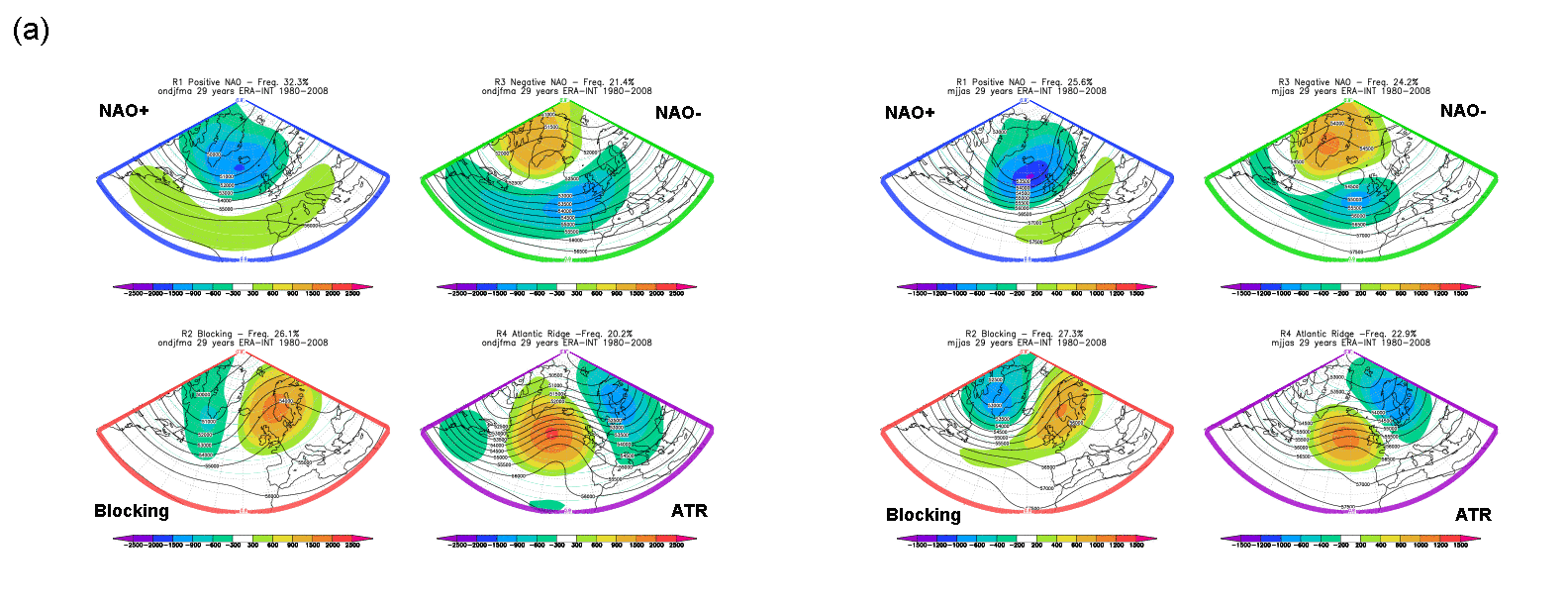
The large-scale air-flow over a region of the earth, which is governed by the height contour patterns, can be considered as inducing or controlling typical weather conditions in an area. The patterns are spatially fairly large, they affect the weather over regions as large as continents and have a persistence of typically ten days or more. These patterns over the Euro-Atlantic region may be described by a few weather regime definitions:
The use of regimes allows increased predictability in the extended range, offsetting the decreasing predictability of synoptic features. Further, some probabilistic assessment may be made of the timing of transitions from one regime to another. There is some connection between weather regimes and surface weather and weather extremes. Specific regimes particularly provide the environmental conditions conducive to large-scale cold spells in winter, heat waves in summer, and widespread heavy precipitation or thunderstorm activity.
ECMWF currently displays extended range forecast data in regime format, based on Euro-Atlantic regimes, using two related schemes:
Each scheme has advantages:
Use of the schemes:
Regime assignment of forecast data is in each case computed in Empirical Orthogonal Function (EOF) space using "calibrated" anomalies of 500mb height/geopotential. These anomalies are computed with respect to the re-forecast 20-year climate (ER-M-climate), and then those anomalies are compared with reference points for the regime definitions (that are themselves based on re-analysis data) in order to achieve regime assignment. Fig74.A and Fig74.B show what these regime reference points look like in 500mb anomaly space for the two schemes. These are for illustrative purposes only – the user should not expect a model forecast assigned to a particular regime to look exactly like these; ordinarily there will just be some vague resemblance.
For the 4-regime scheme, whilst two sets of anomalies are shown, in reality the reference points against which forecast anomalies are compared actually vary smoothly through the year. This is done by giving different weights to these patterns depending upon the month. So for forecasts for the main months of winter and of summer the reference points will be almost identical to that shown in, respectively, the left and right sets in Fig74.A, whilst for intermediate month forecasts they will be a weighted combination.
Fig74.B: Diagrams depict the Euro-Atlantic sector around which the regime definitions used in ECMWF products are based.
The mirrored 2-regime scheme, (used for the Phase Space products), shows only anomalies for the positive modes of the two regimes (NAO+ and BLO+). These patterns are used throughout the year. The negative modes (NAO- and BLO-) are the symmetrical converse of these - imagine multiplying all the anomalies shown by –1.
The regimes in the two schemes can, on the face of it, appear nominally rather similar. However, NAO+ and NAO- regimes in the two schemes, although synonymous, have slightly different meanings. Blocking is similar to BLO+ but they are not quite the same and ATR clearly differs from BLO-.
The use of regimes can be explored at medium range regime charts and extended range regime charts.
Read more about the use of "Weather regimes" at ECMWF (2020 article)